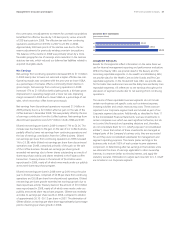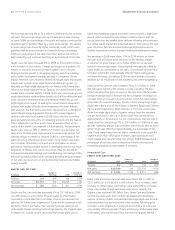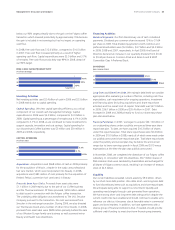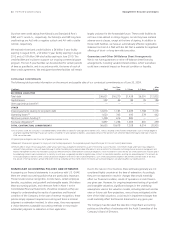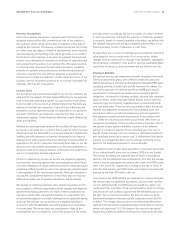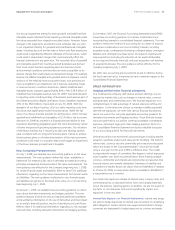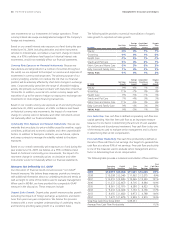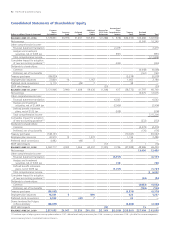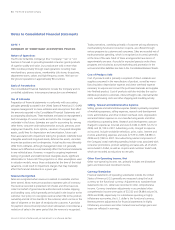Proctor and Gamble 2009 Annual Report Download - page 48
Download and view the complete annual report
Please find page 48 of the 2009 Proctor and Gamble annual report below. You can navigate through the pages in the report by either clicking on the pages listed below, or by using the keyword search tool below to find specific information within the annual report.46 The Procter & Gamble Company Management’s Discussion and Analysis
$50million. The average discount rate on the OPEB plan of 6.4%
reflects the higher interest rates generally applicable in the U.S., which
is where a majority of the plan participants receive benefits. A 0.5%
change in the discount rate would impact annual after-tax OPEB
expense by less than $20million.
Certain defined contribution pension and OPEB benefits in the U.S. are
funded by the Employee Stock Ownership Plan (ESOP), as discussed
in Note 8 to the Consolidated Financial Statements.
Acquisitions
We account for acquired businesses using the purchase method of
accounting. Under the purchase method, our Consolidated Financial
Statements reflect the operations of an acquired business starting from
the completion of the acquisition. In addition, the assets acquired
and liabilities assumed must be recorded at the date of acquisition at
their respective estimated fair values, with any excess of the purchase
price over the estimated fair values of the net assets acquired
recorded as goodwill.
Significant judgment is required in estimating the fair value of intan-
gible assets and in assigning their respective useful lives. Accordingly,
we typically obtain the assistance of third-party valuation specialists
for significant items. The fair value estimates are based on available
historical information and on future expectations and assumptions
deemed reasonable by management, but are inherently uncertain.
We typically use an income method to estimate the fair value of
intangible assets, which is based on forecasts of the expected future
cash flows attributable to the respective assets. Significant estimates
and assumptions inherent in the valuations reflect a consideration of
other marketplace participants, and include the amount and timing of
future cash flows (including expected growth rates and profitability),
the underlying product or technology life cycles, economic barriers to
entry, a brand’s relative market position and the discount rate applied
to the cash flows. Unanticipated market or macroeconomic events
and circumstances may occur, which could affect the accuracy or
validity of the estimates and assumptions.
Determining the useful life of an intangible asset also requires judg-
ment. Certain brand intangibles are expected to have indefinite lives
based on their history and our plans to continue to support and build
the acquired brands. Other acquired brands are expected to have
determinable useful lives. Our assessment as to brands that have an
indefinite life and those that have a determinable life is based on a
number of factors including competitive environment, market share,
brand history, underlying product life cycles, operating plans and the
macroeconomic environment of the countries in which the brands
are sold. Our estimates of the useful lives of determinable-lived
intangibles, primarily including brands, technologies and customer
relationships, are primarily based on these same factors. All of our
acquired technology and customer-related intangibles are expected
to have determinable useful lives.
Other significant estimates associated with the accounting for acqui-
sitions include exit costs. Provided certain criteria are met, exit costs
related to acquired operations are treated as assumed liabilities. If
those criteria are not met, the costs are treated as operating expenses
of the combined company as incurred. Exit costs, consisting primarily
of severance costs, facility closure and other exit costs related to
redundant manufacturing, selling, general and administrative functions,
are based upon plans that have been committed to by management
but which are subject to refinement. Significant estimates and
assumptions inherent in the calculation of exit costs relate to the
number of employees that will be terminated, future costs to operate
and eventually vacate duplicate facilities and costs to terminate agree-
ments. These estimates and assumptions may change as we execute
approved plans. Decreases to the estimated costs are generally
recorded as an adjustment to goodwill. Increases to the estimates are
generally recorded as an adjustment to goodwill during the purchase
price allocation period (generally within one year of the acquisition
date) and as operating expenses thereafter. For acquisitions closed
after June 30, 2009, exit costs will no longer be treated as acquired
liabilities. Rather, they will be charged to expense as incurred post
acquisition in accordance with the applicable new accounting guidance
(see discussion of the new business combinations accounting guidance
in the New Accounting Pronouncements section below).
Goodwill and Intangible Assets
Acquired intangible assets may represent indefinite-lived assets
(e.g., certain trademarks or brands), determinable-lived intangibles
(e.g., certain trademarks or brands, customer relationships, patents
and technologies) or residual goodwill. Of these, only the costs of
determinable-lived intangibles are amortized to expense over their
estimated life. The value of indefinite-lived intangible assets and
residual goodwill is not amortized, but is tested at least annually for
impairment. Our impairment testing for goodwill is performed
separately from our impairment testing of indefinite-lived intangibles.
We test goodwill for impairment, at least annually, by reviewing the
book value compared to the fair value at the reportable unit level.
We test individual indefinite-lived intangibles at least annually by
reviewing the individual book values compared to the fair value. We
determine the fair value of our reporting units based on the income
approach. Under the income approach, we calculate the fair value of
our reporting units based on the present value of estimated future
cash flows. Considerable management judgment is necessary to
evaluate the impact of operating and macroeconomic changes and
to estimate future cash flows to measure fair value. Assumptions used
in our impairment evaluations, such as forecasted growth rates and
cost of capital, are consistent with internal projections and operating
plans. We believe such assumptions and estimates are also comparable
to those that would be used by other marketplace participants. When
certain events or changes in operating conditions occur, indefinite-
lived intangible assets may be reclassified to a determinable life asset
and an additional impairment assessment may be performed. We
did not recognize any material impairment charges for goodwill or
intangible assets during the years presented.



